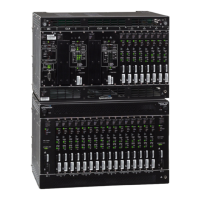44 097-55501-01 Issue 6 – June 2003
1
TimeHub 5500 System Guide
violations (same polarity) on the input. The alignment will be to within tens
of nanoseconds. See Figure for an example of a CC waveform.
To perform an alignment use the following procedure:
• Connect the CC signal that the master shelf is to align with to the
CC IN 1 input on the input connector card (located on the back of
the shelf, right hand sign as you face the back of the shelf). See
Figure for the location of the CC IN 1 connections on the input
connector card. There is no visual indication as to whether the
signal you have connected is actually being received and decoded
properly.
• To activate the alignment use the TL1 keyword CCALIGN. The
exact syntax is shown in the TL1 Reference. When CCALIGN is set
to Y, all output CC signals will be continually aligned with the CC
IN 1 input. A good way to verify that the alignment is occurring is to
observe the CC input (perhaps another one coming from the same
source) and a CC output from the master shelf on a scope. It is
easy to see if the alignment has occurred. Since the CC signals are
balanced and a scope is a single-ended device some provision
should be made to adapt the signals being observed, such as use of
a differential probe or use of an in-line transformer to isolate the
balanced and single-ended sides. However, even without these
steps a reasonable observation of timing relationship between the
two CC signals is usually possible.
If the input and output are not observed to be aligned, possible reasons
include:
• The CC input has a problem, such as no signal is present, signal
levels are incorrect or it has a formatting problem (such as it does
not contain bipolar violations).
• There is a non-zero CC delay enabled on the CC output being
observed. This is covered in the next topic, but the easiest thing to
do is to temporarily disable the CC delay so that alignment is
expected to occur without any timing offset. An alternative is to
take into account the CC delay value that has been programmed
when observing the timing relationships on the scope. For example,
if a 3 us CC delay value has been set (and is enabled) the
expectation on the scope measurement is that alignment is
successful when a 3 us time difference is observed between the CC
input and CC output.
N
OTE
: DS1 outputs on the master shelf are also phase-
adjusted during the CC alignment process.

